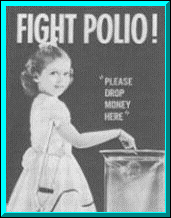









 |
Page 1 | Page
2 | Page 3
The first summer when I was home in Minnesota was that
gosh-awful polio epidemic they had there. We admitted 464 proven cases of polio just
at the University Hospital, which is unbelievable. And this was a very severe
paralytic form. Maybe two or three hours after a lot of these kids would come in
with a stiff neck or a fever, they'd be dead. It was unbelievable. It was just
loads of people that came in, sometimes with only a fever but usually a headache and a
little stiffness in the neck. And just absolutely terrified. At the height of
the epidemic, the people in Minneapolis were so frightened that there was nobody in the
restaurants. There was practically no traffic, the stores were empty. It just
was considered a feat of bravado almost to go out and mingle in public. A lot of
people just took up and moved away, went to another city.
— Richard Aldrich, M.D.
quoted in A Paralyzing Fear
The face of polio changed when the National Foundation for Infantile
Paralysis instituted their March of Dimes campaign. It took control of the war
against this disease out of the hands of a few researchers and doctors and placed it in
the hands of the people. Just as Victory Gardens and scrap drives and paper drives
and civilian air wardens gave individual Americans the power to fight the war against the
axis on the home front, so donating dimes and soliciting for dimes and walking the
neighbourhood collecting dimes empowered the average American to fight the war against
polio personally.
The war against polio looked like the war against the Germans, too.
It had its general staff, the central organization of the National Foundation for
Infantile Paralysis. It had its soldiers in the trenches, the doctors and nurses in
the polio wards. It had its tactical planners, those in medical labs who sought out
the enemy's weaknesses. It had its USO, the volunteers on the home front. It
even had its celebrity promoters, who now lent their names to the drive to support
research as easily as they had once lent their name to war bond sales.

Fundraising poster c. 1950.
An even more powerful weapon was Sister Elizabeth Kenny. She arrived
in the U.S. from Australia in 1940 and introduced a new method of treating polio
patients. Polio patients experienced deep and painful muscle spasms. Doctors
of the time believed that the stronger muscles would pull bones out of alignment when they
were in spasm, and that this produced permanent deformity. As a solution, they
encased patients in rigid casts.
Kenny believed that the casts were a large contributor to the deformity,
and advocated hot packs to relieve the spasms and a program of assisted exercise, whereby
a nurse or technician would move the paralyzed patient through a series of exercises
designed to retrain the muscles.1 Although she originally
met with controversy, the effectiveness of her treatments could not be disputed, and the
National Foundation for Infantile Paralysis granted money to train therapists in
Kenny-style rehabilitation. Within one year, incidence of residual paralysis was
reduced from 85% to 15%.2 In the war against polio, Kenny
had the presence and the stature of MacArthur or Patton.
Polio had always seemed cruel in the way that it targeted children.
Now it seemed hostile. For every action of the March of Dimes that empowered the
populace, for every champion of the children like Sister Kenny, the disease seemed to gain
strength to meet them. In the early 1950s, polio epidemics were rising even faster
than the population, and this was the height of the baby boom.
Year
|
Cases of
Paralytic Polio
|
| 1933 |
5000 |
| 1943 |
12,000 |
| 1946 |
25,000 |
| 1948 |
27,000 |
| 1950 |
33,000 |
| 1952* |
59,000 |
*The polio epidemic of 1952 is notable because serious outbreaks occurred in all
of the forty-eight states, and in the territories of Alaska, Hawaii, and Puerto Rico.3
"By then, polio epidemics were second only to the atomic bomb in
surveys of what Americans feared most. Bomb and virus alike were terrible agents of
destruction that might arrive at any moment to devastate a family, a community, or an
entire nation. The disease seemed like an omnipresent threat, and its cure became a
national responsibility. Epidemics struck other countries, but never as heavily as
here. America was the center of polio, and the place where people knew they must
work first, and fastest, to end it. They gave their time and money to help the
growing swell of victims and to find a way to stem the rising tide of injury. When
the call came, they even volunteered their children, millions of them, to test a new
vaccine. The fear that had once driven Americans apart was now the force that pulled
them together."4
Page 1 | Page
2 | Page 3


Footnotes
1. "Sister Elizabeth Kenny." Australians
Documentary Series. 1998. http://www.abc.net.au/btn/australians/ekenny.htm.
(1 June 1999).
2. Beckstrand, Jan, RN. "History of Nursing
Science." Indiana University Purdue University Indianapolis (professor's
personal Web space). http://www.iupui.edu/~ikux100/petra/histsci.html.
(1 June 1999).
3. Smith, Jane S. Patenting the Sun: Polio and the
Salk Vaccine. New York, New York: William Morrow and Company, Inc.
1990. p. 157.
4. Seavey, Nina Gilden, Jane S. Smith, & Paul
Wagner. A Paralyzing Fear: The Triumph over Polio in America. New
York, New York: TV Books. 1998. pp. 170-171. |
